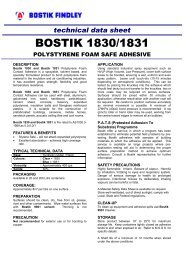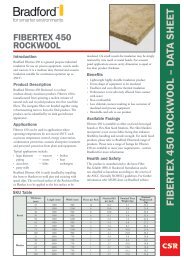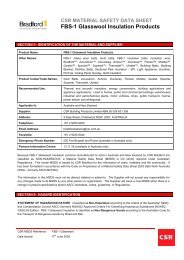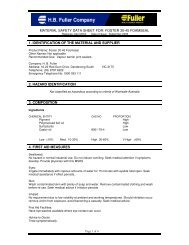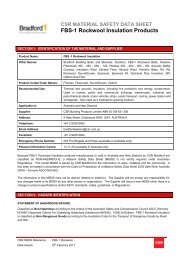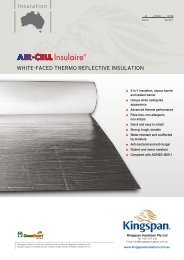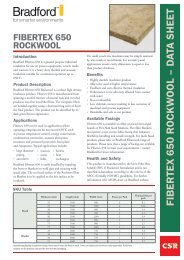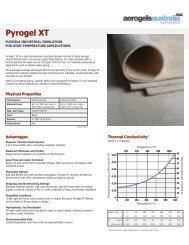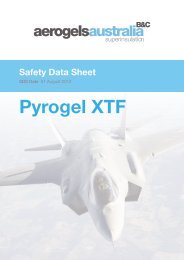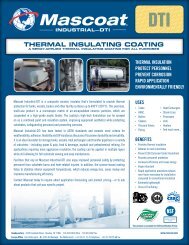Cryogel Z MSDS 2012 - Insulation Industries
Cryogel Z MSDS 2012 - Insulation Industries
Cryogel Z MSDS 2012 - Insulation Industries
You also want an ePaper? Increase the reach of your titles
YUMPU automatically turns print PDFs into web optimized ePapers that Google loves.
Product Name<br />
CRYOGEL Z<br />
9. PHYSICAL AND CHEMICAL PROPERTIES<br />
Appearance<br />
WHITE FABRIC BLANKET WITH FOIL LAMINATE<br />
Odour<br />
ODOURLESS<br />
Flammability<br />
NON FLAMMABLE<br />
Flash point<br />
NOT APPLICABLE<br />
Boiling point<br />
NOT APPLICABLE<br />
Melting point<br />
NOT APPLICABLE<br />
Evaporation rate<br />
NOT APPLICABLE<br />
pH<br />
NOT APPLICABLE<br />
Vapour density<br />
NOT APPLICABLE<br />
Specific gravity<br />
NOT APPLICABLE<br />
Solubility (water)<br />
INSOLUBLE<br />
Vapour pressure<br />
NOT APPLICABLE<br />
Upper explosion limit NOT APPLICABLE<br />
Lower explosion limit NOT APPLICABLE<br />
Autoignition temperature NOT APPLICABLE<br />
Decomposition temperature NOT APPLICABLE<br />
Viscosity<br />
NOT APPLICABLE<br />
Partition coefficient<br />
NOT APPLICABLE<br />
10. STABILITY AND REACTIVITY<br />
Chemical Stability<br />
Conditions to Avoid<br />
Material to Avoid<br />
Hazardous Decomposition<br />
Products<br />
Hazardous Reactions<br />
Stable under recommended conditions of storage.<br />
Avoid heat, sparks, open flames and other ignition sources.<br />
Incompatible with hydrofluoric acid (may evolve toxic silicon tetrafluoride gas).<br />
May evolve toxic gases (carbon oxides) when heated to decomposition.<br />
Polymerization will not occur.<br />
11. TOXICOLOGICAL INFORMATION<br />
Health Hazard<br />
Summary<br />
Eye<br />
Inhalation<br />
Skin<br />
Ingestion<br />
Low toxicity - low irritant. Use safe work practices to avoid eye or skin contact and inhalation. Chronic<br />
exposure to amorphous silica is not anticipated to result in lung disease, however those individuals<br />
with impaired function respiratory or disease are advised to avoid exposure.<br />
Low to moderate irritant. Contact may result in irritation, lacrimation, pain and redness.<br />
Low irritant. Over exposure may result in irritation of the nose and throat, with coughing.<br />
Low irritant. Prolonged or repeated contact may result in mechanical irritation.<br />
Low toxicity. Ingestion may result in gastrointestinal irritation, nausea and vomiting.<br />
Toxicity Data MAGNESIUM HYDROXIDE (1309-42-8)<br />
LD50 (ingestion)<br />
8500 mg/kg (rat, mouse)<br />
LD50 (intraperitoneal) 815 mg/kg (mouse)<br />
TDLo (ingestion)<br />
2747 mg/kg (infant)<br />
12. ECOLOGICAL INFORMATION<br />
Environment<br />
Persistence/Degradability<br />
Mobility<br />
The main component/s of this product are not anticipated to cause any adverse effects to plants or<br />
animals.<br />
Not applicable for inorganic material.<br />
None expected due to insoluble nature of product<br />
13. DISPOSAL CONSIDERATIONS<br />
Waste Disposal<br />
Legislation<br />
Reuse where possible. No special precautions are required for this product.<br />
Dispose of in accordance with relevant local legislation.<br />
Page 3 of 5<br />
SDS Date: 01 Aug <strong>2012</strong>



